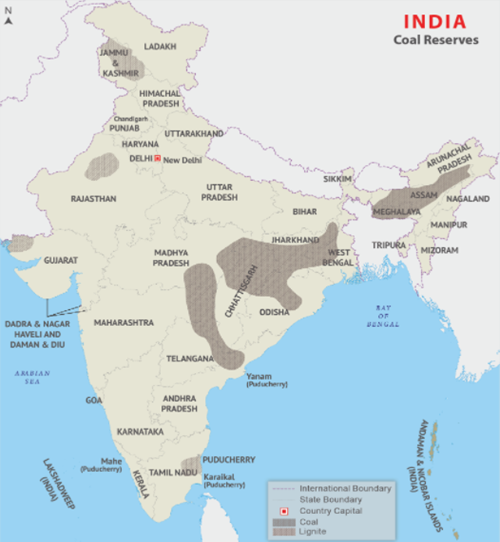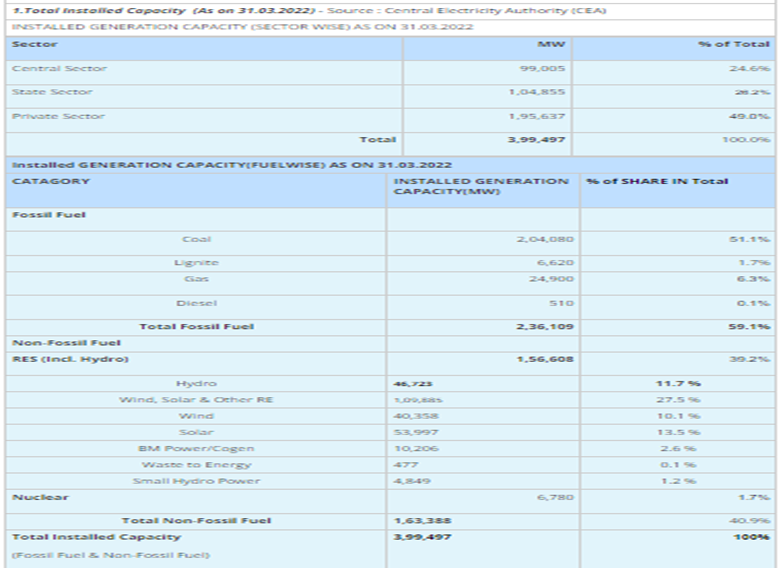In News
- According to the Ministry of Power sources, India is expected to face a wider coal shortage in the quarter ending September due to higher power demand, increasing the risk of widespread power outages.
- According to the same sources, the State-run Coal India, the world's largest coal miner, will import the fuel for use by utilities for the first time since 2015.
What’s in today’s article:
- Distribution of coal reserves across India (About coal, classification of coal, coal reserves in India)
- The statistics related to power in India
- News Summary
Distribution of Coal reserves across India:
- About coal: It is a type of fossil fuel found in a form of sedimentary rocks and is often known as 'Black Gold'. Coal is the main source of energy in India as its share in total power generation is almost 51%.
- Classification of Coal (on the basis of carbon content and time period):
- On the basis of carbon content:
- Anthracite (80 - 95% carbon content, found in small quantities in J&K).
- Bituminous (60 - 80% of carbon content and is found in Jharkhand, West Bengal, Odisha, Chhattisgarh and Madhya Pradesh).
- Lignite (40 to 55% carbon content, high moisture content and is found in Rajasthan, Lakhimpur (Assam) and Tamil Nadu).
- Peat (less than 40% carbon content and it is in the first stage of transformation from organic matter (wood) to coal).
- On the basis of a time period: Gondwana coal (around 98% of India's total coal reserves), Tertiary coal.
- Coal reserves in India (State-wise):

- Jharkhand:
- With estimated 83.15 billion tonnes of reserves which is more than 26% of India’s total reserves, Jharkhand ranks first.
- The state’s main coal-mining centers are Jharia (India’s oldest and richest coalfield), Bokaro, Auranga, Giridh, Dhanbad, Ramgarh, Karanpur and Hutar.
- Odisha: Second on the list for coal reserves is the state of Odisha (over 24% of the country’s total reserves and about 15% of India’s total coal production). Talchar is Odisha's biggest coalfield.
- Chattisgarh: Chhattisgarh has the third largest coal reserve in India and carries about 17% of the total coal reserves. However, the state has the first rank in the production of coal. Coalfields of the state include Korba, Hasdo-Arand, Chirmiri, Jhimli, and Johilla.
- Others are West Bengal (about 11% of the total coal reserves of India), Madhya Pradesh (about 8%), Andhra Pradesh (7%), Maharashtra, Rajasthan, Gujarat, Tamil Nadu, Jammu and Kashmir.
The statistics related to power in India:

News Summary:
- India expects a domestic coal supply of 154.7 million tonnes, 42.5 million tonnes short of the projected requirement of 197.3 million tonnes in the September quarter.
- The grim forecast demonstrates the extent of India's fuel shortage due to -
- Projections showing that annual power demand will grow at the fastest rate in at least 38 years.
- Record highs global coal prices due to a supply crunch caused by the Russia-Ukraine crisis.
- The higher coal demand could also stifle efforts to build power plant inventories. Despite this, most states had yet to award contracts to import coal and Indian utilities would run out of coal by July if no coal was imported.
- As a result, the Indian government has increased pressure on utilities to increase imports.
- It would be the first time since 2015 that Coal India has imported the fuel, highlighting efforts by state and central officials to stock up to avoid a repeat of April, when India faced its worst power cuts in more than six years.
- Coal India would import coal for blending on government-to-government (G2G) basis and supply to thermal power plants of state generators and independent power producers (IPPs).
- Higher imports could put further pressure on State-Government-owned power distribution companies, which are already in debt and owe billions of dollars to generators as they have historically absorbed higher input costs to keep tariffs steady.









